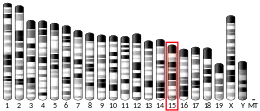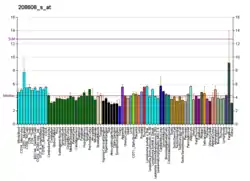SNTB1
Beta-1-syntrophin is a protein that in humans is encoded by the SNTB1 gene.[4][5][6]
| SNTB1 | |||||||||||||||||||||||||||||||||||||||||||||||||||
|---|---|---|---|---|---|---|---|---|---|---|---|---|---|---|---|---|---|---|---|---|---|---|---|---|---|---|---|---|---|---|---|---|---|---|---|---|---|---|---|---|---|---|---|---|---|---|---|---|---|---|---|
| Identifiers | |||||||||||||||||||||||||||||||||||||||||||||||||||
| Aliases | SNTB1, 59-DAP, A1B, BSYN2, DAPA1B, SNT2, SNT2B1, TIP-43, syntrophin beta 1 | ||||||||||||||||||||||||||||||||||||||||||||||||||
| External IDs | OMIM: 600026 MGI: 101781 HomoloGene: 9618 GeneCards: SNTB1 | ||||||||||||||||||||||||||||||||||||||||||||||||||
| |||||||||||||||||||||||||||||||||||||||||||||||||||
| |||||||||||||||||||||||||||||||||||||||||||||||||||
| |||||||||||||||||||||||||||||||||||||||||||||||||||
| |||||||||||||||||||||||||||||||||||||||||||||||||||
| Wikidata | |||||||||||||||||||||||||||||||||||||||||||||||||||
| |||||||||||||||||||||||||||||||||||||||||||||||||||
Function
Dystrophin is a large, rod-like cytoskeletal protein found at the inner surface of muscle fibers. Dystrophin is missing in Duchenne Muscular Dystrophy patients and is present in reduced amounts in Becker Muscular Dystrophy patients. The protein encoded by this gene is a peripheral membrane protein found associated with dystrophin and dystrophin-related proteins. This gene is a member of the syntrophin gene family, which contains at least two other structurally related genes.[6]
Interactions
SNTB1 has been shown to interact with Dystrophin.[7]
References
- GRCm38: Ensembl release 89: ENSMUSG00000060429 - Ensembl, May 2017
- "Human PubMed Reference:". National Center for Biotechnology Information, U.S. National Library of Medicine.
- "Mouse PubMed Reference:". National Center for Biotechnology Information, U.S. National Library of Medicine.
- Ahn AH, Yoshida M, Anderson MS, Feener CA, Selig S, Hagiwara Y, Ozawa E, Kunkel LM (Jun 1994). "Cloning of human basic A1, a distinct 59-kDa dystrophin-associated protein encoded on chromosome 8q23-24". Proc Natl Acad Sci U S A. 91 (10): 4446–50. Bibcode:1994PNAS...91.4446A. doi:10.1073/pnas.91.10.4446. PMC 43802. PMID 8183929.
- Rousset R, Fabre S, Desbois C, Bantignies F, Jalinot P (Mar 1998). "The C-terminus of the HTLV-1 Tax oncoprotein mediates interaction with the PDZ domain of cellular proteins". Oncogene. 16 (5): 643–54. doi:10.1038/sj.onc.1201567. PMID 9482110.
- "Entrez Gene: SNTB1 syntrophin, beta 1 (dystrophin-associated protein A1, 59kDa, basic component 1)".
- Ahn AH, Kunkel LM (Feb 1995). "Syntrophin binds to an alternatively spliced exon of dystrophin". J. Cell Biol. 128 (3): 363–71. doi:10.1083/jcb.128.3.363. PMC 2120343. PMID 7844150.
Further reading
- Ahn AH, Kunkel LM (1995). "Syntrophin binds to an alternatively spliced exon of dystrophin". J. Cell Biol. 128 (3): 363–71. doi:10.1083/jcb.128.3.363. PMC 2120343. PMID 7844150.
- Yang B, Ibraghimov-Beskrovnaya O, Moomaw CR, Slaughter CA, Campbell KP (1994). "Heterogeneity of the 59-kDa dystrophin-associated protein revealed by cDNA cloning and expression". J. Biol. Chem. 269 (8): 6040–4. doi:10.1016/S0021-9258(17)37566-X. PMID 8119949.
- Ahn AH, Freener CA, Gussoni E, Yoshida M, Ozawa E, Kunkel LM (1996). "The three human syntrophin genes are expressed in diverse tissues, have distinct chromosomal locations, and each bind to dystrophin and its relatives". J. Biol. Chem. 271 (5): 2724–30. doi:10.1074/jbc.271.5.2724. PMID 8576247.
- Gee SH, Madhavan R, Levinson SR, Caldwell JH, Sealock R, Froehner SC (1998). "Interaction of muscle and brain sodium channels with multiple members of the syntrophin family of dystrophin-associated proteins". J. Neurosci. 18 (1): 128–37. doi:10.1523/jneurosci.18-01-00128.1998. PMC 6793384. PMID 9412493.
- Hasegawa M, Cuenda A, Spillantini MG, Thomas GM, Buée-Scherrer V, Cohen P, Goedert M (1999). "Stress-activated protein kinase-3 interacts with the PDZ domain of alpha1-syntrophin. A mechanism for specific substrate recognition". J. Biol. Chem. 274 (18): 12626–31. doi:10.1074/jbc.274.18.12626. PMID 10212242.
- Blake DJ, Hawkes R, Benson MA, Beesley PW (1999). "Different dystrophin-like complexes are expressed in neurons and glia". J. Cell Biol. 147 (3): 645–58. doi:10.1083/jcb.147.3.645. PMC 2151186. PMID 10545507.
- Newey SE, Benson MA, Ponting CP, Davies KE, Blake DJ (2001). "Alternative splicing of dystrobrevin regulates the stoichiometry of syntrophin binding to the dystrophin protein complex". Curr. Biol. 10 (20): 1295–8. doi:10.1016/S0960-9822(00)00760-0. PMID 11069112. S2CID 18104833.
- Marchand S, Stetzkowski-Marden F, Cartaud J (2001). "Differential targeting of components of the dystrophin complex to the postsynaptic membrane". Eur. J. Neurosci. 13 (2): 221–9. doi:10.1046/j.1460-9568.2001.01373.x. PMID 11168526.
- Hogan A, Shepherd L, Chabot J, Quenneville S, Prescott SM, Topham MK, Gee SH (2001). "Interaction of gamma 1-syntrophin with diacylglycerol kinase-zeta. Regulation of nuclear localization by PDZ interactions". J. Biol. Chem. 276 (28): 26526–33. doi:10.1074/jbc.M104156200. PMID 11352924.
- Kutsenko AS, Gizatullin RZ, Al-Amin AN, Wang F, Kvasha SM, Podowski RM, Matushkin YG, Gyanchandani A, Muravenko OV, Levitsky VG, Kolchanov NA, Protopopov AI, Kashuba VI, Kisselev LL, Wasserman W, Wahlestedt C, Zabarovsky ER (2002). "NotI flanking sequences: a tool for gene discovery and verification of the human genome". Nucleic Acids Res. 30 (14): 3163–70. doi:10.1093/nar/gkf428. PMC 135748. PMID 12136098.
- Gevaert K, Goethals M, Martens L, Van Damme J, Staes A, Thomas GR, Vandekerckhove J (2004). "Exploring proteomes and analyzing protein processing by mass spectrometric identification of sorted N-terminal peptides". Nat. Biotechnol. 21 (5): 566–9. doi:10.1038/nbt810. PMID 12665801. S2CID 23783563.
- Leonoudakis D, Conti LR, Anderson S, Radeke CM, McGuire LM, Adams ME, Froehner SC, Yates JR, Vandenberg CA (2004). "Protein trafficking and anchoring complexes revealed by proteomic analysis of inward rectifier potassium channel (Kir2.x)-associated proteins". J. Biol. Chem. 279 (21): 22331–46. doi:10.1074/jbc.M400285200. PMID 15024025.
- Okuhira K, Fitzgerald ML, Sarracino DA, Manning JJ, Bell SA, Goss JL, Freeman MW (2006). "Purification of ATP-binding cassette transporter A1 and associated binding proteins reveals the importance of beta1-syntrophin in cholesterol efflux". J. Biol. Chem. 280 (47): 39653–64. doi:10.1074/jbc.M510187200. PMID 16192269.
- Kawai-Yamada M, Saito Y, Jin L, Ogawa T, Kim KM, Yu LH, Tone Y, Hirata A, Umeda M, Uchimiya H (2006). "A novel Arabidopsis gene causes Bax-like lethality in Saccharomyces cerevisiae". J. Biol. Chem. 280 (47): 39468–73. doi:10.1074/jbc.M509632200. PMID 16192270.
- Ejtehadi HD, Freimanis GL, Ali HA, Bowman S, Alavi A, Axford J, Callaghan R, Nelson PN (2006). "The potential role of human endogenous retrovirus K10 in the pathogenesis of rheumatoid arthritis: a preliminary study". Ann. Rheum. Dis. 65 (5): 612–6. doi:10.1136/ard.2004.031146. PMC 1798125. PMID 16192292.
- Chen Z, Hague C, Hall RA, Minneman KP (2006). "Syntrophins regulate alpha1D-adrenergic receptors through a PDZ domain-mediated interaction". J. Biol. Chem. 281 (18): 12414–20. doi:10.1074/jbc.M508651200. PMID 16533813.
This article is issued from Wikipedia. The text is licensed under Creative Commons - Attribution - Sharealike. Additional terms may apply for the media files.



